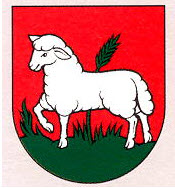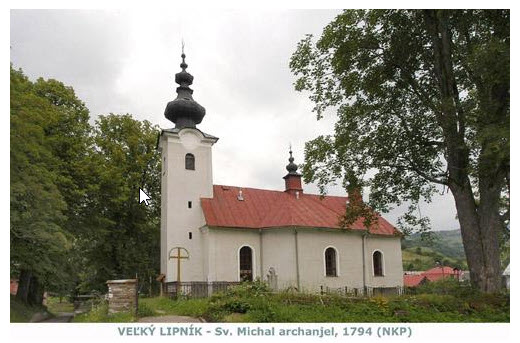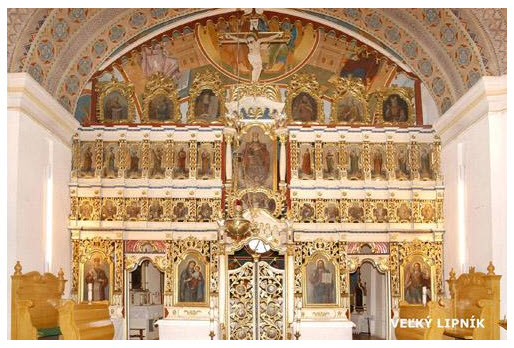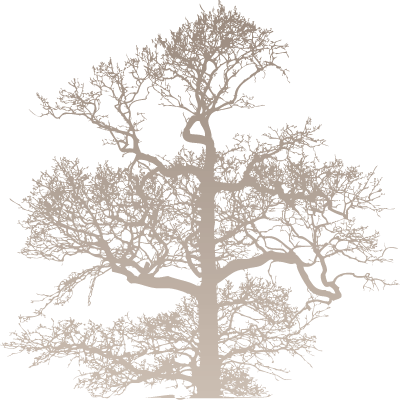
The village of Vel’ky Lipník began behind the Spišská Magura mountain range which is part of the outer western Carpathian mountains which reach to the international border with Poland. Settlement began in this area early but in the second half of the 13th century during the reign of Hungarian King Béla IV, Ruthenians and Germans settled in the area during the years of 1235 to 1270. During the years 1308 to 1342 Hungarian King Karol Róbert donated this area to Julius Gorgey from Spišský Hrhov-Gargov. In 1314 the first written mention of Veľký Lipník was made. During the 15th and 16th century the village was inhabited mostly by Ruthenians from Southern Poland (Galicia.) They mostly worked as farmers and also bred various livestock. Due to their working mostly on farms, the village crest which was utilized from the 16th to the 19th century denoted this trade.
Along with farming, the residents of Veľký Lipník also worked in folk crafts (making carpets, linens, folk clothing) and many male inhabitants worked making rope and rope based products. During the turn of the century, life was very difficult in this village. Agriculture was declining and there were no other employment opportunities in this area. A mass immigration of residents began and their destinations were mostly the United States and Canada. After World War II a number of families were relocated to Soviet Ukraine. Some later returned to Veľký Lipník to resume their former lives. In this region there are several Unesco world heritage sites. The closest are the Wooden Churches in Poland which are 26 miles away. Tourism has expanded during the past number of years in this region and Pension Daniella offers accommodations with four apartments and a restaurant that was newly constructed in the center of Veľký Lipník. The Pension offers trips by car to see historical monuments such as Stara Lubovna Castle, Kezmarok and Niedzica. They also schedule trips to the High Tatras along with visits to Vysne Ruzbachy for spa treatments at the thermal swimming pools.
Over time there have been varying names for the village:
1330, Lupnik, 1338 Fellyupnik or Felwpnik, 1396 Lyndona, Lyndnou and in 1770 Lipnik.
1773, 1786 Lipnik, 1808 Lipnik, Laupnik, 1863–1902 Nagylipnik, 1907–1913 Nagyhársas, 1920 Veľký Lipník, 1927–1945 Veľký Lipník, Velikij Lipnik, 1945– Veľký Lipník.
Village Size:
The village rests at an altitude of 580 meters and covers an area of 27.513 km.
Church:


Photos Provided by, The Greek Catholic Archbishop of Presov
The Greek Catholic Church of Saint Michael the Archangel was constructed of stone in 1794, prior to this a wooden church structure existed. Previous Pastors of the church were 1700-1703 Jan Ihumensky, 1703-1706, Vasil’ Ladizinsky, 1747 to 1747, Simon Zeleznik, 1748-1757, Andrej Ladizinsky, 1757-1794, Juraj Smekovsky, 1794-1802, Jan Petrikovic, 1802-1828, Jan Burik, 1828-1830, Andrej Hodobay, 1830-1831, Alexej Lejcak, 1831-1832-Stefan Bistey, 1832-1843, Jozef Dudinsky, 1843-1844, Jan Grajcary, 1844-1847, Jan Takac, 1848-1858, Atanaz Jaromis, 1858-1868, Bernard Deak, 1869-1911, Stefan Chanath, 1911-1920, Michal Milly. The current Pastor is Father Luboslav Pulscak and the church has approximately 800 Greek Catholic parishioners. The exterior of the church is cream color stone with a dark roof. A one column bell tower is capped by a cupola. Two other smaller cupola’s rest farther back on the roof. A wooden two bar memorial cross sits to the right of the entrance. The church interior is very well decorated on the ceiling with various designs in red, yellow, brown and blue. A four tier iconostasis is on the altar of gold and white with blue trim. At the top of the iconostasis is a two bar cross. A red vigil lamp hangs from the ceiling in front of the royal doors. Beautiful murals of Jesus Christ teaching children and the sermon on the mountain grace the ceiling. Flags with the Sacred Heart of Jesus and Immaculate Heart of Mary are near the front of the church. Three chrystal chandeliers hang from the ceiling. In the rear of the church two procession altars on the walls show the Most Sacred Heart of Jesus and Our Lady of Mariapocs. The interior color of the church walls are yellow with white trim and a magnificent walk up sermon pulpit is locaterd on the left side of the exterior altar. Near the front right of the iconstansis are a side altar dedicated to Our Lady of Perpeutual Help and on the main wall a large mural portraying Jesus Christ’s Divine Mercy which has become a beloved devotion among Greek Catholics in recent years.
Population:
As of 2018, approximately 945 residents.



